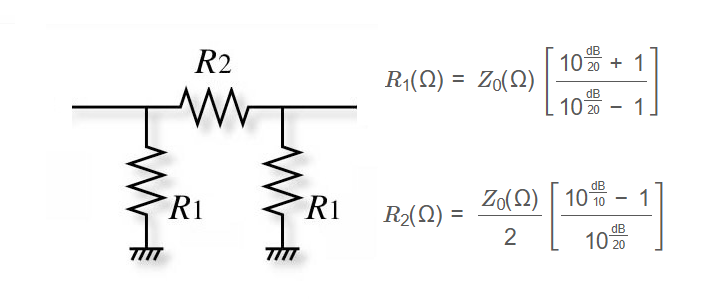1. What is a Pi Attenuator Calculator?
Definition: This calculator determines the resistor values \( R1 \) (shunt resistors) and \( R2 \) (series resistor) for a Pi attenuator circuit based on the desired attenuation and the characteristic impedance \( Z_0 \).
Purpose: It helps engineers and RF designers select appropriate resistor values for attenuator circuits used in RF and microwave applications to control signal levels while maintaining impedance matching.
2. How Does the Calculator Work?
The calculator uses the following formulas to compute the resistor values:
Shunt Resistor \( R1 \):
\[
R_1(\Omega) = Z_0(\Omega) \left[ \frac{10^{\frac{\text{dB}}{20}} + 1}{10^{\frac{\text{dB}}{20}} - 1} \right]
\]
Series Resistor \( R2 \):
\[
R_2(\Omega) = \frac{Z_0(\Omega)}{2} \left[ \frac{10^{\frac{\text{dB}}{10}} - 1}{10^{\frac{\text{dB}}{20}}} \right]
\]
Where:
- \( R1 \): Shunt resistor value in ohms (same for both shunt resistors in the Pi configuration)
- \( R2 \): Series resistor value in ohms
- \( Z_0 \): Characteristic impedance in ohms (e.g., 50 ohms for typical RF systems)
- dB: Attenuation in decibels
Unit Conversions:
- Attenuation:
- 1 Np = 8.686 dB
- Impedance and Resistors (\( R1, R2 \)):
- 1 kΩ = 1000 Ω
- 1 mΩ = 0.001 Ω
Steps:
- Enter the desired attenuation and select the unit (dB or Np).
- Enter the characteristic impedance \( Z_0 \) and select the unit (ohms, kΩ, or mΩ).
- Click "Calculate" to compute \( R1 \) and \( R2 \).
- The results are initially displayed in ohms.
- Select a different unit for each resistor (ohms, kΩ, or mΩ) from the dropdowns after each result to convert the displayed values.
3. Importance of Pi Attenuator Calculation
Calculating resistor values for a Pi attenuator is essential for:
- Signal Control: Attenuators reduce signal amplitude without distorting the waveform, critical in RF systems.
- Impedance Matching: Ensures minimal signal reflection in high-frequency circuits.
- Design Efficiency: Helps engineers select standard resistor values for practical implementation.
4. Using the Calculator
Examples:
- Example 1: Attenuation = 10 dB, \( Z_0 \) = 50 ohms, Results in ohms
- \( 10^{\frac{10}{20}} = 10^{0.5} \approx 3.162 \), \( 10^{\frac{10}{10}} = 10 \)
- \( R1 = 50 \times \frac{3.162 + 1}{3.162 - 1} \approx 96.23 \, \text{ohms} \)
- \( R2 = \frac{50}{2} \times \frac{10 - 1}{3.162} \approx 71.17 \, \text{ohms} \)
- Example 2: Attenuation = 0.691 Np, \( Z_0 \) = 0.075 kΩ, Results in mΩ
- Convert: Attenuation = \( 0.691 \times 8.686 \approx 6 \, \text{dB} \), \( Z_0 = 0.075 \times 1000 = 75 \, \text{ohms} \)
- \( 10^{\frac{6}{20}} = 10^{0.3} \approx 1.995 \), \( 10^{\frac{6}{10}} \approx 3.981 \)
- \( R1 = 75 \times \frac{1.995 + 1}{1.995 - 1} \approx 225.75 \, \text{ohms} \)
- \( R2 = \frac{75}{2} \times \frac{3.981 - 1}{1.995} \approx 55.92 \, \text{ohms} \)
- Results in mΩ: \( R1 = 225750 \, \text{mΩ} \), \( R2 = 55920 \, \text{mΩ} \)
- Example 3: Attenuation = 3 dB, \( Z_0 \) = 60000 mΩ, Results in kΩ
- Convert: \( Z_0 = 60000 \times 0.001 = 60 \, \text{ohms} \)
- \( 10^{\frac{3}{20}} = 10^{0.15} \approx 1.4125 \), \( 10^{\frac{3}{10}} \approx 1.995 \)
- \( R1 = 60 \times \frac{1.4125 + 1}{1.4125 - 1} \approx 351.27 \, \text{ohms} \)
- \( R2 = \frac{60}{2} \times \frac{1.995 - 1}{1.4125} \approx 21.15 \, \text{ohms} \)
- Results in kΩ: \( R1 = 0.3513 \, \text{kΩ} \), \( R2 = 0.0212 \, \text{kΩ} \)
5. Frequently Asked Questions (FAQ)
Q: What is a Pi attenuator?
A: A Pi attenuator is a circuit configuration used in RF systems to reduce signal power while maintaining impedance matching, consisting of two shunt resistors (\( R1 \)) and one series resistor (\( R2 \)) in a π-shaped topology.
Q: Can this calculator be used for other attenuator types?
A: No, this calculator is specific to Pi attenuators with the given formulas. Other configurations (e.g., Tee or Bridged-Tee attenuators) require different formulas.
Q: What if the calculated resistor values are not standard?
A: In practice, select the closest standard resistor value (e.g., E12 or E24 series) or use a combination of resistors to approximate the calculated values.
Pi Attenuator Calculator© - All Rights Reserved 2025
 Home
Home
 Back
Back
